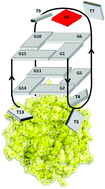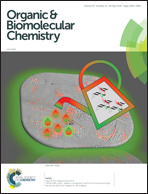Manipulation of a DNA aptamer–protein binding site through arylation of internal guanine residues†
Abstract
Chemically modified aptamers have the opportunity to increase aptamer target binding affinity and provide structure–activity relationships to enhance our understanding of molecular target recognition by the aptamer fold. In the current study, 8-aryl-2′-deoxyguanosine nucleobases have been inserted into the G-tetrad and central TGT loop of the thrombin binding aptamer (TBA) to determine their impact on antiparallel G-quadruplex (GQ) folding and thrombin binding affinity. The aryl groups attached to the dG nucleobase vary greatly in aryl ring size and impact on GQ stability (∼20 °C change in GQ thermal melting (Tm) values) and thrombin binding affinity (17-fold variation in dissociation constant (Kd)). At G8 of the central TGT loop that is distal from the aptamer recognition site, the probes producing the most stable GQ structure exhibited the strongest thrombin binding affinity. However, within the G-tetrad, changes to the electron density of the dG component within the modified nucleobase can diminish thrombin binding affinity. Detailed molecular dynamics (MD) simulations on the modified TBA (mTBA) and mTBA–protein complexes demonstrate how the internal 8-aryl-dG modification can manipulate the interactions between the DNA nucleobases and the amino acid residues of thrombin. These results highlight the potential of internal fluorescent nuclobase analogs (FBAs) to broaden design options for aptasensor development.

- This article is part of the themed collection: Nucleic Acid Modifications


 Please wait while we load your content...
Please wait while we load your content...